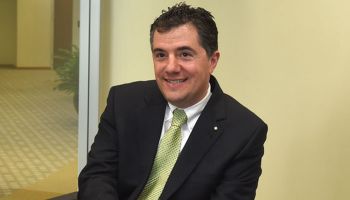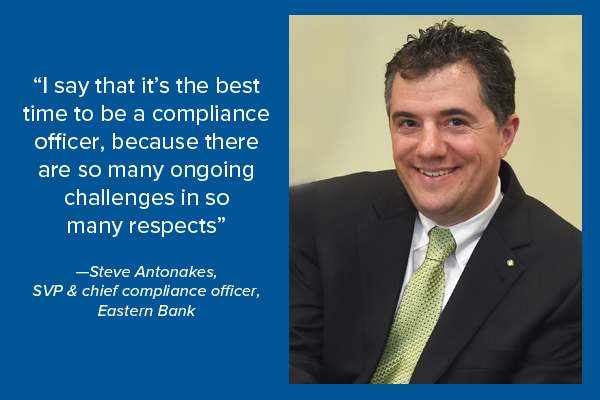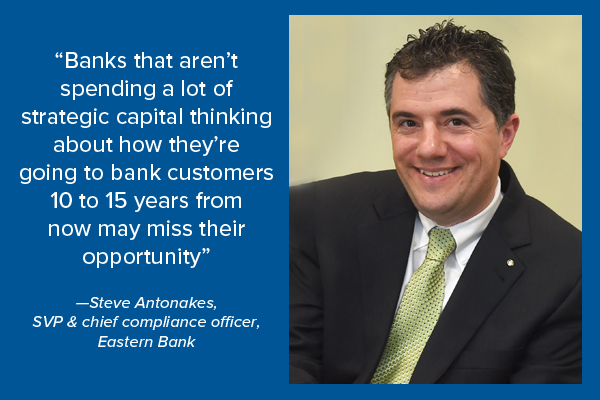How former CFPB official handles compliance
Eastern Bank’s Steve Antonakes brings experience to bank side of the table
- |
- Written by Steve Cocheo
 Former #2 regulator at CFPB Steve Antonakes now drives a building up of compliance at Eastern Bank. He shares his perspectives on disclosure and more, and how Eastern prepares to cross the $10 billion threshold.
Former #2 regulator at CFPB Steve Antonakes now drives a building up of compliance at Eastern Bank. He shares his perspectives on disclosure and more, and how Eastern prepares to cross the $10 billion threshold.
“Anyone who’s gotten a mortgage knows how much white noise there is in the disclosure process,” says Steve Antonakes, senior vice-president and chief compliance officer at Massachusetts’ Eastern Bank. By the time the mortgage closes, the file has likely grown three inches thick, Antonakes says.
“Disclosure requirements are generally well-meaning,” he says, “but you have a myriad of federally mandated disclosures, state-mandated disclosures, bank forms that their lawyers put in there, and more. If anyone actually ever read every single document, and understood it, every loan closing would take three to five days versus the couple of hours that they do.”
Of course, if you know the compliance business of banking, you likely know that Antonakes is not just a disgruntled or philosophical compliance officer.
Bankers spend a great deal of time and money on regulation, and part of that consists of trying to get into regulators’ heads. Bankers go to conferences, read regulations, hire consultants, and more, to find out how to handle rules and laws.
Eastern Bank, nearing the $10 billion-assets threshold and pushing the banking envelope in other ways, decided last year that instead of trying to get into the regulatory head, there was a better way: Hire the head.
And so Antonakes, who served for a bit over two years as deputy director at the Consumer Financial Protection Bureau, and was also Massachusetts’s banking commissioner, began working at Eastern Bank last year.
Time to build up
As $9.9 billion Eastern prepared to cross the $10 billion line, which brings, among other things, direct CFPB supervision, it wanted a veteran who knew the ground in place. As Richard Holbrook, chairman and CEO explains in the June-July Banking Exchange cover story, management knew Antonakes, and Antonakes knew the bank. It was a good time for a good fit.
Antonakes says he had a number of reasons for joining Eastern. In a way, this was a symbolic homecoming for him, after spending five years in Washington in federal service.
“I was born and raised a mile and half from the operation center [in Lynn, Mass.] where I work, so it’s my hometown bank,” he says. “My parents banked with Eastern and I had an account here before I began my regulatory career.”
But that personal connection is overshadowed by what Eastern has been up to. Antonakes is impressed with the ways that Eastern serves its communities. (The bank gives 10% of its profits to charity.)

He sees good potential in the developments coming out of Eastern Labs, the bank’s fintech shop. And he appreciates the challenge of helping a conservative bank upgrade its compliance and risk-management approaches as it goes a little further out on the risk curve and compliance challenges grow, seemingly daily.
“I’ve heard a lot of people say that it’s the worst time to be a compliance officer,” says Antonakes. “But I say that it’s the best time to be a compliance officer, because there are so many ongoing challenges in so many respects.”
Volume of disclosures, from two perspectives
But let’s turn back to that matter of disclosure. Antonakes has been on both sides of the regulatory relationship. That puts his view on disclosures into interesting perspective:
“The bureau tried to improve the disclosure situation when it introduced the combined TILA/RESPA forms,” he says. “We’ll see how that does.” [The use of the combined form was required as of August 2015.] Antonakes adds that the bureau was investing “fairly significant resources” in developing simpler, electronic pages where the technology would point consumers to the most important disclosures. The experiments were also going to measure how much time the readers actually spent on the screen, which both bankers and regulators would find of interest.
“I think that makes a lot of sense,” says Antonakes. “Overall, I think the jury is still out in terms of whether our disclosure-heavy regime has actually provided the consumer benefits that we intended.”
He adds that there are probably a handful of key disclosures that banks could put in front of consumers that they will read and where they should really focus.
“But no one can go through hundreds of pages of technical jargon and actually pretend that they are a better educated consumer at the end of the day,” Antonakes says.
As more and more banking happens on mobile devices—though online applications have been a sticking point in many institutions—the issue of mobile disclosure comes up. Antonakes is very interested in this, though it is not something he or Eastern Labs are working on right now.
“Whether the delivery of the disclosure is paper or electronic it’s still an open question how much information and in what form it truly results in a better customer experience and a better informed customer at the end of the day,” says Antonakes. He adds that technology may provide bankers with advantages in compliance and disclosure that they hadn’t had before.
“That’s a broader conversation for regulators, policymakers, consumers advocates, and others,” says Antonakes. “We’d love to be part of that. If you could get this right, you could save costs for the industry, costs for consumers, and provide key information before consumers made decisions.”
Indeed, Antonakes hopes to help Eastern establish an independent voice on federal and state banking issues where the bank can offer a viewpoint, based on its expertise, beyond the general input that industry trade associations provide.
“There are some bills that may be important enough for us that we want to take our own stand,” he explains.
Antonakes says he’s sympathetic to community bankers’ disgust with Dodd-Frank—“It’s been a tough run.” Pushback on compliance comes in many forms, and he still gets some when he’s out in the field.
“Many community bankers stuck to their knitting and yet now have layers upon layers upon layers of regulation that they have to endure because of all the bad actors who contributed to the financial crisis,” says Antonakes. “By the same token, you can only howl at the moon so long. You have to accept the reality of the world that we’re in and the compliance risk and associated reputational risk.”

Measure compliance to your strategy
Antonakes says bankers must match their compliance program to their strategic plan, especially if the bank plans to grow.
“It can’t just be the compliance officer in the cellar doing the job anymore, because the work has become too complex, and the stakes have risen too much,” says Antonakes. Evidence that more banks “get” this lies in the difficulty in finding and hiring compliance talent these days. He’s been in the job coming on a year now and is still filling some jobs—one post would fit “a lawyer who loves math.”
At Eastern, he is spending a good deal of time implementing a “three lines of defense” approach to compliance. In brief, this means the business line becomes the first place where compliance is enforced, and the accountability begins there. The second line is Compliance proper. The third bastion is Internal Audit.
This is coming to be a model for many banks, beyond those larger institutions that the concept initially was conceived for. At the recent Regulatory Compliance Conference of the American Bankers Association the usage was clearly becoming common lingo.
Antonakes has also been beefing up the tools of Eastern's compliance.
“We’ve been building self-testing mechanisms, metrics, means of reporting, and in general formalizing the compliance process,” he explains. “And building out the team and the expertise they have.”
One effort has been an emphasis on Compliance reviews of the bank’s first line.
“Historically here the compliance team has done what I would describe as a series of narrow dives looking at compliance with specific laws, such as truth in lending,” Antonakes explains. “We have moved towards a more holistic, product-based review. So, we’ll go in and do a deep dive in mortgage originations, for example, to see kind of cover-to-cover what that process looks like. We’re doing this for all of the major products we offer.”
In a sense, it is a dry run of sorts for more intensive examinations. For example, CFPB often conducts examinations by business area, rather than necessarily whole-bank exams, so this is of a piece with the ex-regulator’s background. This is similar in concept to the “horizontal” exams the prudential lenders have done in targeted banking areas with groups of banks, over the years.
Antonakes also emphasizes making more use of complaints, to delve into root causes and see if the compliance program has weak spots.
A long to-do list is underway, but it’s one that a bank crossing the line must undertake. Working in concert with Eastern Labs, the fintech operation headed by Dan O’Malley (See “Inside Eastern Labs”), Antonakes sees new products such as Easter’s Express Business Loan keeping the bank relevant and creating new opportunities.
“Dan’s small business product will be great for opening doors to folks that may have been shut out of small business financing in the past,” says Antonakes. “Banks need to seize this market, invest in this space rationally, reasonably, and sustainably. That’s versus products that would put people perhaps in a worse space.”
Antonakes has looked at the offerings of marketplace lenders and finds them a mixed bag from a compliance perspective.
“Some do it very well and I’m guessing some may cut corners or just haven’t focused on compliance,” he says. (You can only see so much without entering personal data.)
Regulatory attention to these nonbank players is also mixed. Antonakes notes that CFPB has already indicated it is looking at consumer marketplace lenders—it doesn’t have jurisdiction over business-oriented marketplace lenders at this point.
Overall, he thinks these players have helped banks by pushing them to move faster into fintech. “Do I think they are going to be able to push banks out of this space with cheaper technology? I don’t think so. I think bank’s funding advantages, their advantage in customer acquisition, will help. But it will be interesting to see how this evolves, whether it is partnerships or head-to-head competition or if ‘light charters’ are devised.”
For bankers who see Compliance as the "Department of No," Antonakes adds this caveat: “Banks that aren’t spending a lot of strategic capital thinking about how they’re going to bank customers 10 to 15 years from now may miss their opportunity.”
Tagged under Compliance, Compliance Management, Compliance/Regulatory, Consumer Compliance, Feature, Feature3,













